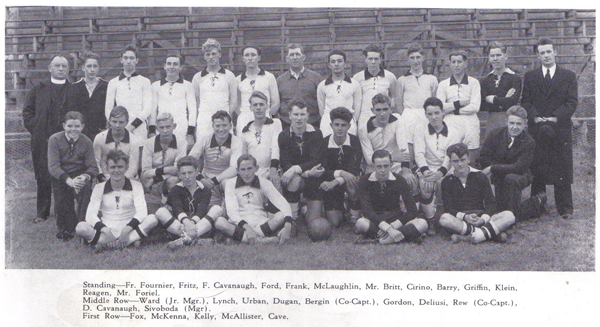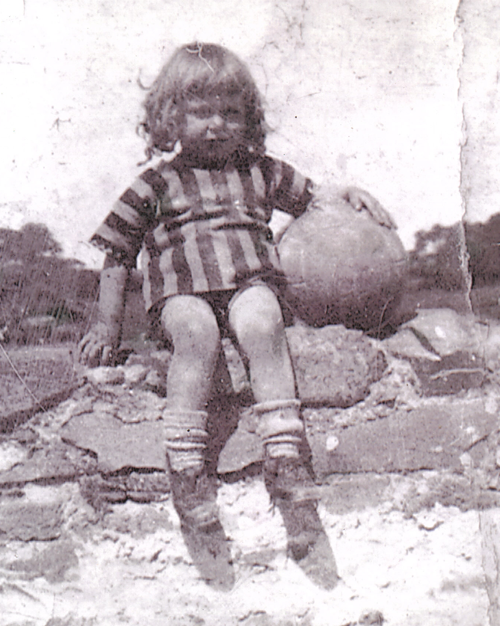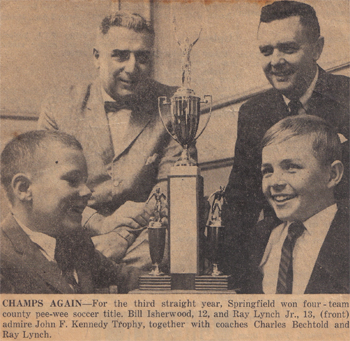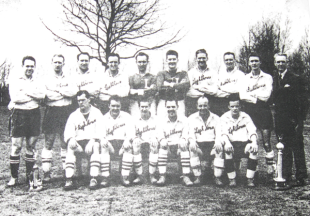Photo: Ray Lynch (front row, second from the left) with Lighthouse Boys Club in 1940. Photo courtesy of Jim Lynch.
In February, I received an email from Carol Lynch-Smyth that read, “Hello, Can you tell me if my 94 yr old father Ray Lynch is the oldest living member of Lighthouse Boys Club?”
I responded that I couldn’t say for sure but certainly would be interested in talking to Ray.
Carol told me that, while he is 94, her father still lives on his own and “has a memory that is sharp as nails.” She neglected to mention that, as I would soon learn, he also has a terrific sense of humor and is a member of the Springfield Hall of Fame, Delaware County Soccer Hall of Fame, North Catholic Hall of Fame, and Southeastern Pennsylvania Soccer Hall of Fame.
I called Ray, who kindly invited me to meet with him and one sunny Sunday in March, I took the train out to Morton-Rutledge station in Springfield, where his son Jim picked me up.
Ray’s story isn’t just that of a Scotch-Irish immigrant playing his father’s game with Lighthouse, it’s also part of the story of movement of soccer in the US from its urban origins to the suburbs.
From Glasgow to Kensington and Lighthouse
Ray Lynch was born in Glasgow, Scotland in 1921, living with his family in a house just two blocks from Celtic Park. His family was Catholic and father, John, was originally from Ireland, so naturally, they were Celtic supporters.
Times were tough after the First World War in Britain, especially for someone who worked in the shipbuilding trade like Ray’s father. In 1924, John crossed the Atlantic to Philadelphia in search of work and a new home for his family.
“My father came first, about three or four months ahead of us to get a job. He came to Philadelphia because of the shipbuilding trade,” Ray told me. John found a job in Chester before bringing his family over, living first in West Philadelphia before settling in Kensington.
John had played soccer in Scotland and he soon joined Kensington Bluebells, a team largely made up of Scottish and Irish immigrants like himself.
“We lived in the lower end of Kensington. Kind of a melting pot of Irish, Scots, German, and Jewish people,” Ray recalled. “It was a mixture. But soccer was very strong down there, of course. It was the sport in Kensington at the time, even through the 50s, 60s, and 70s.”
Soccer was the main topic of conversation in the Lynch household and like so many boys, Ray was soon playing the game of his father, joining Lighthouse Boys Club.
“I was about 9 years old,” Ray said. “I went up to assistant director when I was going to college later on.”
Ray wasn’t only involved in soccer from a young age, boxing was another sporting interest. But Ray was also interested in music.
When he was 8 years old, he sang on the radio for the first time on WPEN, beginning a life-long involvement in show business. It seems to have run in the family: his uncles back in Scotland performed as the Nichols’ Brothers.
Ray performed as a teenager on the Horn and Hardart Children’s Hour radio program, which was produced at WCAU Radio in Philadelphia beginning in 1927 until it moved to NBC Radio in New York in 1947. Ray’s vocal skills were soon noticed by talent scouts and he was offered a contract to go to Hollywood. Sadly, it was not to be.
“My mother said no,” Ray said, adding with a chuckle, “Dad wasn’t even in the picture.”
Not that she didn’t support his singing. One time he was in a talent show and the mother of another performer said her son would win the completion, hands down. After that, Ray’s mother told him he’d better win the talent show.
“I won it,” Ray laughed. “Naturally.”
“It was quite a game in those days”
Ray was a soccer fan as well as a player, attending, among others, Philadelphia German American games with his father.
“They brought in a fellow from New England to play center forward,” Ray remembered. “They needed more power up front.” That fellow was Bert Patenaude who, before joining the German Americans in the 1933-34 ASL season, had scored the first hat trick in World Cup history playing for the US in Uruguay in 1930.
Because teams like the German Americans played in small urban stadiums, fans were up close to the action. “It was like sitting ringside,” Ray said.
Ray continued playing with Lighthouse, joining his high school team his freshman year at North Catholic as a left halfback in 1935. But his budding soccer career was almost tragically cut short after his first season with the team.
“When I was 14 years old I was in an accident on a bicycle and I lost four toes on my left foot,” Ray said. “14 years old! Let me tell you, for a year I was pathetic, I couldn’t do anything, you know?”
After two months in Frankford Hospital, Ray spent the next two years recovering from his injury. Before the start of his senior year in 1938, he asked his doctor if he could tryout for the North Catholic varsity squad. His doctor thought returning to soccer might be good therapy and gave his approval. Not only did Ray make the team, he was made assistant captain.
North Catholic played their home games at the Kensington Athletic Association’s grounds. And they were good.
That year, North Catholic was undefeated, defeating Simon Gratz, 1-0, for the city’s Scholastic Soccer Championship at the Simon Gratz home field at 18th Street and Hunting Park Avenue.
“Simon Gratz was a real power with the Germans and the Polish,” Ray said. It was also, along with Northeast High School, a big rival “because a lot of them belonged to Lighthouse Boys Club.” Later in senior club leagues, those Lighthouse teammates and high school rivals might be teammates or rivals once again.

The 1938 championship North Catholic team. Ray is in the second row, second from the left. Photo courtesy of Jim Lynch.
North Catholic’s 1938 Yearbook notes, “because of the interest in this rapidly growing sport at North Catholic, the park was usually crowded with Falcon rooters.” High school and club games were big events in Kensington.”They’d get nice crowds, two or three thousand,” Ray recalled.
Club soccer in Philadelphia was divided into three divisions at the time, with Ray moving up from Lighthouse in the third division to play for first division sides Kensington Bluebells as well as Phoenix of the First German Sports Club, whose clubhouse was in North Philadelphia before it purchased land in Feasterville in Bucks County in 1938.
Ray described how Bluebells fans reflected the ethnic identity of the club. “They would sing songs, Irish songs, Scottish songs.”
And fans, coming from the tight-knit Kensington neighborhood, had long memories.
“When you had a bad day, they’d say, ‘You weren’t as good as your father.’ I had to live that down all the time,” Ray remembered with a laugh.
“I remember with the Bluebells, they were ecstatic if you won, you could have anything in the place. When you lost, I used to take my clothes and go home.
“I lived about four blocks away on Water Street. My dad would never see me play because he was afraid of me getting hurt. So I’d walk in and he’d say, ‘So, you lost again, huh?’ If I came home showered he’d say, ‘So, you won?'”
There was money to be made playing soccer. Ray recalled that at Phoenix, “They paid us $8 if you won, $7 if you tied, $6 if you lost. It wasn’t bad, $8, because you could take a girl out for three weeks.”
As was the case with the Bluebells, wins were enthusiastically celebrated. “They’d give you a great time after a game, all the beer you wanted. I didn’t drink, anyway.
“It was quite a game in those days.”
Founding the Springfield Soccer Club
Ray moved to Springfield in Delaware County in the 1950s, working for a crane company after college, though he and his family returned frequently to visit relatives and friends in Kensington. He soon joined the Springfield Athletic Association and in 1960 he proposed two sports to be added to the association, boxing and soccer. They chose soccer, and Ray started the Springfield Soccer Club with 35 boys.
“Parents were very enthused, because we were taking care of their kids,” Ray said. “We told them from the very beginning that we’d teach all the intricacies of soccer, but you have to take on personal values: recognizing the rights of others, parents, teachers, the police. You see the value of that, getting it into their minds when they’re 8 to 16 years old.”
He added, “It was sort of a family affair, you know what I mean? You got together with the kids and their family.”
While participation in the club became something of a family affair for those involved, parents weren’t necessarily coming from a soccer background like Ray had.
“They got involved in the game because the youngsters were benefiting from it,” Ray said. “I think that’s what it was. I don’t recall that any of them had been involved in soccer [before].” The club has grown from those first 35 boys to have well over 1200 boys and girls playing intramural and travel soccer.
Ray would write reports on the club for the local newspaper, the Springfield Press. In an article he wrote in 1963, Ray praised the efforts of the mothers involved in the club, referring to them as “soccer moms,” perhaps one of the earliest, if not the first, time the phrase was used in print.
Recalling the article, Ray said with a laugh, “I should’ve taken a copyright out on it.”
Like father, like son
Ray’s son Jim followed in the soccer footsteps of his grandfather and father, and has long been involved with the Springfield Soccer Club. Jim’s son, Jim, Jr., also played for the club and is now the soccer coach at Chichester Middle School where he is a teacher. Jim’s daughter Katie, who lives in New Jersey, has a young son who has also begun to play, making for five generations of soccer players since John Lynch settled with his family in Philadelphia from Glasgow in 1924.
Recalling the club’s early days at Springfield’s Memorial Park, Jim said, “Goalposts were a rarity out here. We used to get, besides the big orange cones, big sticks and just drive them into the ground. But they would take a couple of hits and they were falling down.”
“There’s goals there now, there’s goals everywhere,” Ray added.
Describing his family’s involvement with the club, Ray said, “I had it for the first 25 years, he had it for the second.”
“I’m at 29 years,” Jim replied.
“He’s still coaching,” Ray said. “He can’t get away from it.”
Like father, like son.




Great article, Ed. Can you imagine Soccer in Kensignton back in the day?
“I lived about four blocks away on Water Street.”
.
Very interesting. I had family that lived on Water Street at about that time.
.
And Mr. Lynch’s immigration story pretty closely matches my grandmother’s family – except for her it was about a dozen years earlier, and my great-grandfather was searching for work in the textile industry.
.
Fascinating story. Thanks for digging into it and sharing it, Ed!
Ed you did a GREAT job. Told our Family Story
Enjoyed the Philly flavor here.
Ed, your articles you write are FANTASTIC, keep ’em coming. This article takes me back to my first year playing, first game with a boys club called Mayfair Red Devils a 2 sport club baseball/basketball, decided to sport a soccer team due to growing interest and we played Lighthouse for a spanky defeat of 10 -0 !!! Later that first year we were ‘tied’ by Lighthouse late game and our coach was so proud of us I’ll never forget it… My genuine thnx to the coach a gentleman I believe his name was Charles Scullion? circa 1966/67. Keep up the great writing Ed, Thnx again… Founding member, Section 127. GO UNION!!!
Thanks for your information U-FANBQ! I’m Chuck Scullion and played on the Red Devils for my father. It was the start of a wonderful journey through a great game, with multiple stops throughout North America!
ED that was a great article on Ray he was one of our inductees into our Hall of Fame
Great memory Ed, that was the first year for the Red Devils and my Dad Charlie Scullion was the coach. Your memory with Lighthouse is on the money too. The first game was at Lighthouse and we lost 10-0, only due to the sportsmanship of Lighthouse coach Warren Beideman who put the brakes on. We played them later in the season at Lincoln , our home field and it was a tie! Thanks for the great memories!
Chuck Scullion